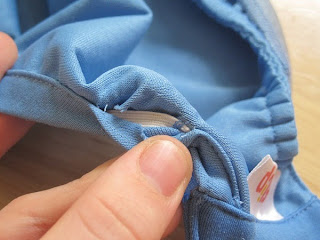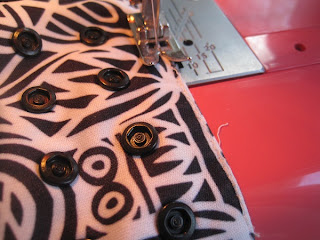I've been using cloth nappies for the Squid for a year now, and really loving it. I recently bought four Bumgenius Organics (or old style Elementals) for cheap, as the elastic was very slack. I set about repairing them, and am very please with the finished results. Thought I'd share how I did it, for other parents out there who want their nappies to last a little longer.
Here's a good comparison shot - the blue nappy (left) has had the elastic repaired, the black one (right) has not. The difference is pretty clear!
Here's another comparison, with the bigger one on top :
For this repair you will need:
- A Bumgenius Organic (also referred to as an 'old' Elemental)
- Scissors
- Seam ripper
- Sewing machine with straight stitch and zig-zag stitch functions
- Three pieces of elastic, 6mm wide (1/4 inch), 4.5 inches long
- Small safety pins
- Thread in white and something the matches the threads on the outside of your nappy
- A wee bit of patience
We will be replacing the leg elastic, the back waist elastic, and also separating the soakers/inserts at the front for easier folding and quicker drying.
1 - Open the nappy along the front, above where the poppers are (or velcro, if it's got velcro). Open it enough to fit your hand in, about 3-4 inches. Turn the nappy inside out.
2 - Using the seam ripper, take off both leg elastics. The stitches are very small, so take your time and make sure not to rip the PUL (waterproof outer layer). Take note of where the original elastic is attached (in line with the second row of rise poppers). You can use a safety pin to mark.
3 - I found that because of the way the elastic is attached and the nappy sewn, some of it is hard to remove without hurting the PUL.
4 - If you find this, just cut the elastic, leaving a small stub at the end (this also gives you a good stop and start point for exactly where the elastic should be attached).
5 - Attach new elastic. Use a straight stitch first to secure it, then switch to a zig-zag. Pull the elastic taut as you sew. You should find it fits exactly when pulled tight. Start at the rise popper end, PUL side up, and sew it directly onto the serged edging. Here, I've used black so it shows up better, but it doesn't really matter as it's on the inside. Repeat for both legs.
6 - Now onto the back waist elastic. Feel along the edge of the nappy to find a little lump, this is where the elastic is attached. If you're lucky, a bit of elastic may be poking out.
7 - Using the seam ripper, open up where the elastic is attached, about 7 stitches or so. Do the same at both ends.
8 - Using a small safety pin, attach the new elastic to the old at one end, then unpick the old elastic at that same end. At the other end, pull the old elastic through the casing and the new elastic should come with it. Attach the new at both ends with a safety pin, and then using straight stitch, sew the ends to the nappy. Again, be mindful of sewing it onto the serged edging.
9 - Turn the nappy outside in, and sew around the space where the back elastic is attached. This is a little tricky (and a bit hard to explain!). Basically, just follow the original stitching to replace what you unpicked earlier.
Now, if you don't want to remove the front end of the insert, skip ahead to step 14. I would recommend doing it though. It will help your nappy dry quicker, makes it easier to fold when the nappy is on the smaller rise settings and also makes it easier to boost.
10 - Turn the nappy inside out again, and find where the insert is attached at the FRONT of the nappy.
11 - Using your seam ripper, unpick all the stitches until you have remove the small rectangle of fabric. Get rid of that little rectangle of fabric, and try to remove as many bits of thread as you can
12 - Turn the nappy right side out again. In some of the nappies, the inserts are sewn together at the front end, so unpick this.
13 - Here are the two inserts detached from the front, showing how much easier they are to fold now. It will leave holes, but I've found that with a few washes these holes close up and they make no difference to the performance of the nappy while being worn.
14 - Now with your nappy turned right side out, all that's left to do is use a straight stitch to close up the front hole (yes, I have a pink sewing machine, because I am awesome).
And that's you all done! Here's the finished nappy, being compared with the blue one, and the old elastic compared with the new, big difference huh?
People have asked me before about holes in their Bumgenius Organic nappies, holes that have appeared in the cotton layer that covers the PUL. These holes are fine to leave, you can repair them by hand-sewing or patching them - but really, they are just cosmetic and don't affect the nappy's performance.
I've also been asked about 'wicking' that can occur with this style of nappy (where the wee leaks through the leg holes onto clothes). This is easily avoided by making sure all the cotton is tucked in around the leg opening, you should not be able to see any cotton on the outside when the baby is wearing the nappy.
I was going to round this post off with a cute Squid in fluff picture, but he moves too fast!




































